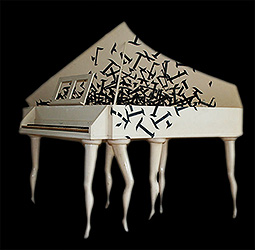Das Cembalo – einst „das“ Tasteninstrument der Barockzeit –
wurde nach langer Pause erst im 20. Jahrhundert von den Komponisten wieder entdeckt, zunächst mit historisierender Tendenz im Rückgriff auf
barocke Formen und Kompositionstechniken.
Erst die zweite Hälfte des Jahrhunderts machte sich das expressive
Potenzial des Instruments in ganz neuen ästhetischen
und stilistischen Zusammenhängen zunutze.
Tatsächlich ist das Cembalo zu einem der wichtigsten Instrumente der Neuen Musik avanciert; Werke wie Khoai für Solo-Cembalo von Xenakis oder
Continuum für Cembalo (1968) von György Ligeti gelten als Meilensteinen
der zeitgeössischen Musik.
The harpsichord - once " the " key instrument of the Baroque period - was discovered after a long break until the 20th century by the composer again , first with historicist tendency in the use of Baroque forms and compositional techniques .
It was not until the second half of the century made the expressive Potential of the instrument in entirely new aesthetic and stylistic contexts advantage . In fact, the harpsichord has become one of the main tools of contemporary music ; Works for solo harpsichord as Khoai Xenakis or Continuum apply for Harpsichord ( 1968) by György Ligeti as milestones of contemporary music.

promoting contemporary harpsichord music
http://www.procembalo.org/
Foundation Annelie de Man
One side of Roderick de Man about and for his wife" Annelie de Man ," which has been used for a lifetime of contemporary harpsichord music.

http://www.admf.nl/NL/english_main.html
Dissertation on „Contemporary Harpsichord music“
Contemporary harpsichord music: Issues for composers and performers
by Lindorff, Joyce Zankel, D.M.A., THE JUILLIARD SCHOOL, 1982, 122 pages; 3420131
http://gradworks.umi.com/3420131.pdf
Mauricio Kagel, Rezitativarie für singende Cembalistin (1972) Mimiko, Basel, Catalina Vicens, Harpsichord & Chant


























